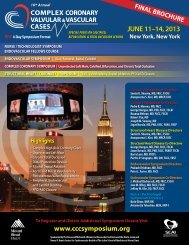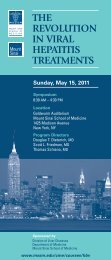WOM N WOM N - Mount Sinai Hospital
WOM N WOM N - Mount Sinai Hospital
WOM N WOM N - Mount Sinai Hospital
Create successful ePaper yourself
Turn your PDF publications into a flip-book with our unique Google optimized e-Paper software.
L’ORÉAL PARIS<br />
SURVIVOR DAY<br />
OF BEAUTY<br />
<strong>WOM</strong> N<br />
<strong>WOM</strong> TO<br />
N<br />
The <strong>Mount</strong> <strong>Sinai</strong> <strong>Hospital</strong><br />
One Gustave L. Levy Place, Box #1252<br />
New York, New York 10029<br />
newsletter<br />
THE <strong>WOM</strong>AN TO <strong>WOM</strong>AN NEWSLETTER | THE MOUNT SINAI HOSPITAL GYNECOLOGIC CANCER SUPPORT PROGRAM<br />
<strong>WOM</strong> N<br />
<strong>WOM</strong> TO<br />
N<br />
VOL. 3, NO. 1 | FALL 2008<br />
(Above) Vivian Port,<br />
Woman To Woman<br />
Survivor Volunteer, with<br />
Ann McLaughlin, ovarian<br />
cancer survivor, <strong>Mount</strong><br />
<strong>Sinai</strong> <strong>Hospital</strong>.<br />
(Left) Myrtice Wooten,<br />
Woman to Woman<br />
Survivor Volunteer,<br />
with Kerry Washington,<br />
Actress and L’Oréal<br />
Paris Spokesperson<br />
showing support<br />
for Ovarian Cancer<br />
Awareness.<br />
<strong>WOM</strong>AN TO <strong>WOM</strong>AN LUNCH<br />
WITH THE GYNECOLOGIC ONCOLOGY<br />
DIVISION AT MOUNT SINAI<br />
(Left To Right) Dr. Peter Dottino, Dr. Dimitry Lerner, Valerie Goldfein, Nancy Irizarry,<br />
Joyce Manheimer, Arden Moulton, Dr. Jamal Rahaman, Pamela Herman Elliott,<br />
Julianne Bond, Vivian Port, Dr. Monica Prasad Hayes, Dr. Rudy Segna.<br />
Photo by Dr. William Bradley<br />
know the symptoms<br />
ovarian cancer<br />
1 . Vague but persistent and unexplained<br />
gastrointestinal complaints such as gas,<br />
nausea, and indigestion<br />
2 Pelvic and/or abdominal swelling and/or pain;<br />
bloating and/or feeling of fullness, increased<br />
abdominal size<br />
3 Unexplained changes in bowel habits<br />
4 Unexplained weight gain or loss<br />
5 Frequency and/or urgency of urination<br />
6 New and unexplained abnormal<br />
postmenopausal bleeding<br />
7 Fatigue<br />
8 Backache<br />
uterine cancer<br />
9 New and unexplained abnormal bleeding<br />
10<br />
cervical cancer<br />
A Pap test is used to detect cervical cancer,<br />
not ovarian or uterine cancer.<br />
Every woman should<br />
undergo an annual rectal<br />
and vaginal pelvic<br />
examination.<br />
If an irregularity of the ovary is detected,<br />
or if some of the vague symptoms are<br />
expressed, further testing should be<br />
performed. This may include a CA-125<br />
blood test and a transvaginal sonogram.<br />
According to an article in the<br />
Journal of the American Medical<br />
Association,* studies indicate that<br />
ovarian cancer is not a silent disease;<br />
most women had symptoms in the<br />
year prior to diagnosis. In fact, 89%<br />
of women with stage I/II disease and<br />
97% of women with advanced disease<br />
reported symptoms.<br />
*Goff BA, Mandel LS, Melancon CH, Muntz HG.<br />
“Frequency of symptoms of ovarian cancer<br />
in women presenting to primary care clinics.”<br />
JAMA 2004;291:2705-2712<br />
“you are<br />
not alone”<br />
VALERIE GOLDFEIN<br />
Founder<br />
Program Coordinator<br />
ARDEN MOULTON<br />
Editor<br />
VIVIAN PORT<br />
PHOTOGRAPHY<br />
ALAN MANHEIMER<br />
EDITORIAL ASSISTANCE<br />
KEN ATKATZ<br />
DESIGN<br />
JESSICA WEBER DESIGN, INC., NYC<br />
<strong>WOM</strong>AN TO <strong>WOM</strong>AN<br />
ADVISORY BOARD<br />
JAMIE BORIS<br />
CARMEL COHEN, MD<br />
MARY COSGROVE, MD<br />
PETER DOTTINO, MD<br />
ANNE BUSH FEELEY, RN<br />
VALERIE GOLDFEIN<br />
FAITH KATES KOGAN<br />
CYNTHIA LEVY<br />
SARA PASTERNAK, PHD<br />
JENNIFER PECK<br />
JAMAL RAHAMAN, MD<br />
RUDY SEGNA, MD<br />
VIRGINIA WALTHER, LCSW<br />
ROBIN ZAREL, LCSW<br />
Thanks to the Holland<br />
Family Foundation for its<br />
support of the newsletter.<br />
WITH GRATITUDE TO THE<br />
OVARIAN CANCER RESEARCH<br />
FUND FOR THEIR SUPPORT.<br />
<strong>WOM</strong>AN TO <strong>WOM</strong>AN<br />
The <strong>Mount</strong> <strong>Sinai</strong> <strong>Hospital</strong><br />
Department of Social Work Services<br />
One Gustave L. Levy Place, Box #1252<br />
New York, New York 10029<br />
Tel: 212.241.3793<br />
FROM THE EDITOR<br />
“TO KNOW THE ROAD AHEAD,<br />
ASK THOSE COMING BACK.”*<br />
THIS, OUR THIRD ANNUAL NEWSLETTER, HAS A<br />
double focus: educating women and their families about<br />
gynecologic cancers, their prevention, early detection,<br />
treatment options, and associated quality of life issues; and<br />
exploring how scientists are progressing on new discoveries<br />
VIVIAN PORT<br />
*Chinese Proverb<br />
All materials © <strong>Mount</strong> <strong>Sinai</strong> <strong>Hospital</strong> 2008<br />
for their prevention, treatment, and cure.<br />
In this issue: Dr. Tamara Kalir is featured<br />
in the first in a series of planned interviews<br />
with scientists and doctors at <strong>Mount</strong> <strong>Sinai</strong><br />
involved in cutting-edge research; Dr.<br />
Karen Brown, Director of Cancer Genetic<br />
Counseling, tells us what we can learn<br />
from our genes; our Program Coordinator,<br />
Arden Moulton, introduces our new<br />
educational programs; Dr. Jamal Rahaman<br />
describes the many clinical trials now<br />
offered in the Division of Gynecologic<br />
Oncology; and finally, we show how<br />
Woman to Woman survivor volunteers are<br />
serving as “patient teachers” for secondyear<br />
medical students.<br />
I also want to highlight the work of<br />
Barbara A. Goff, MD, whose 2004 article is<br />
referenced on our back cover. Her<br />
4 | A VOLUNTEER’S EXPERIENCE<br />
“I’ve gained more than I’ve given.”<br />
symptom-screening index is being<br />
evaluated by M. Robyn Andersen, PhD,<br />
and colleagues at the University of<br />
Washington, in a pilot study to assess the<br />
value of using it as a screening tool among<br />
normal-risk women. We look forward<br />
to learning the results. Early detection<br />
remains our best defense.<br />
And, again, I urge everyone to contact<br />
their Senators and Representatives<br />
regarding the Ovarian Cancer Biomarker<br />
Research Act, introduced in Congress<br />
a year ago, and still in committee.<br />
Fortunately, funding through the<br />
Department of Defense Ovarian Cancer<br />
Research Program was increased from 10<br />
to 20 million dollars, which is very<br />
encouraging news. We need more.<br />
6 | DR. KALIR AND <strong>WOM</strong>AN TO <strong>WOM</strong>AN PANEL PRESENTATION<br />
“Patients’ stories are a contribution to the emotional<br />
component of learning.”<br />
8 | COLLABORATIONS: GENETICS COUNSELING AND TESTING<br />
“What we don’t know really can hurt us...”<br />
| THE NEWSLETTER | 1
interview with<br />
JAMAL RAHAMAN, MD<br />
The Division is a major training center for Fellows in<br />
the field of gynecologic oncology and Dr. Rahaman has<br />
been Director of the Gynecologic Oncology Fellowship<br />
Program since 2006.<br />
“In New York, with eleven gynecologic oncologists,<br />
we have the biggest complement of faculty and the largest<br />
volume of patients treated for benign and gynecologic<br />
cancer surgeries,” he explained.<br />
When Dr. Rahaman gave me a demonstration of<br />
the dynamic and interactive electronic platform he<br />
developed for the Division, it became clear that he is<br />
the Division’s “techie” extraordinaire. He explained how<br />
the platform allows anyone in the Division to prescribe<br />
or track a patient’s treatment, onsite or offsite, allowing<br />
for efficiency and continuity of care. Appointments and<br />
schedules can be accessed as well.<br />
“This past year, there has been an increase from<br />
900 cycles of chemotherapy to 1,300-1,500 cycles, an<br />
increase in volume as well as access to clinical trials,”<br />
he said. A system such as this is designed to make it<br />
all run smoothly. Dr. Rahaman is the Director of the<br />
Chemotherapy Infusion Service.<br />
All Attending Physicians are co-investigators of<br />
trials, so any doctor can enroll patients. Supervisory<br />
responsibility for each trial is divided among the<br />
Attendings. Since 2006, when the Division joined the<br />
2 | THE NEWSLETTER |<br />
Dr. Jamal Rahaman, who is an Associate Professor, <strong>Mount</strong><br />
<strong>Sinai</strong> School of Medicine, and an Attending Physician in the<br />
Department of Obstetrics, Gynecology, and Reproductive<br />
Science since 1998, has been instrumental in helping to expand the<br />
Division of Gynecologic Oncology. In his own words, “The Division has<br />
moved from its reputation for top-notch surgeons to a comprehensive<br />
Division that is also a major research center with investigator-initiated<br />
clinical trials [those initiated at <strong>Mount</strong> <strong>Sinai</strong>], national trials through<br />
the Gynecologic Oncology Group [the collaborative national research<br />
organization], and basic science and translational research [scientific<br />
research with possible clinical applications].”<br />
GOG, 15 national clinical trials have opened up at<br />
<strong>Mount</strong> <strong>Sinai</strong>. There are clinical trials for ovarian,<br />
endometrial, and cervical cancers. Studies comparing<br />
different chemotherapy agents in various stages of<br />
disease are being conducted in endometrial and ovarian<br />
cancer. There is a study of pre-operative imaging for<br />
cervical cancer. There is a prospective (before disease)<br />
study of women at increased genetic risk for ovarian<br />
cancer, and another study of the effect of zoledronic acid<br />
to build up bone mineral density for the lumbar spine<br />
in women who have elected risk-reducing surgery to<br />
remove both ovaries. In addition, a tissue biorepository<br />
has been developed to freeze and store human<br />
gynecologic tissue to use in studying causes, diagnosis,<br />
prevention, and treatment of cancer—some to go into<br />
a national bank and some into our own. Dr. Rahaman<br />
is very excited to be the principal investigator of two<br />
GOG trials currently open, which allow women with<br />
ovarian cancer free access to Avastin (Bevacizumab)<br />
in combination with standard chemotherapy for firstline<br />
(GOG 218) and second-line therapy (GOG 213).<br />
<strong>Mount</strong> <strong>Sinai</strong> participated in international clinical<br />
trials that led to development of the HPV vaccine<br />
Gardasil by Merck, which was approved two years ago.<br />
At this time, <strong>Mount</strong> <strong>Sinai</strong> has two investigational studies<br />
about vaccines. Dr. Rahaman, who is co-investigator<br />
of these trials with Dr. Rhoda Sperling—Professor<br />
and Vice Chair of Research for the Department of<br />
Obstetrics, Gynecology, and Reproductive Science, and<br />
Professor of Medicine, Infectious Diseases—explained:<br />
“We are working with both Merck and Glaxo-Smith<br />
Kline. Glaxo-Smith Kline has another vaccine that’s not<br />
approved in the US yet, but will be, hopefully, within the<br />
next two years. Merck is now looking at a new vaccine<br />
with nine strains versus the current four strains. That<br />
trial is open right now.”<br />
There is a tremendous breadth of clinical trials<br />
taking place now, because of the Division’s membership<br />
in the Gynecologic Oncology Group, established<br />
by the efforts of Drs. Dottino and Segna in 2006.<br />
The Division holds a monthly translational research<br />
meeting with scientists and doctors from different<br />
departments, including Breast and<br />
Oncological Sciences, to brainstorm<br />
new projects. The Fellows work in<br />
different labs within Oncological<br />
Sciences. Dr. Rahaman expects that<br />
this exciting research will translate<br />
into cutting-edge trials offered<br />
only here at <strong>Mount</strong> <strong>Sinai</strong>, resulting<br />
in the development of improved<br />
treatments and potential cures.<br />
Many may not know that<br />
Dr. Rahaman had completed a<br />
fellowship in Cardiothoracic and Vascular Surgery at<br />
the Texas Heart Institute in Houston, Texas, with Dr.<br />
Denton Cooley as his mentor, before completing his<br />
Obstetrics and Gynecology Residency and Gynecologic<br />
Oncology Fellowship at <strong>Mount</strong> <strong>Sinai</strong>. Following his<br />
training, Dr. Rahaman left <strong>Mount</strong> <strong>Sinai</strong> to be an<br />
Attending Physician at Williamson ARH <strong>Hospital</strong><br />
in South Williamston, Kentucky, where he became<br />
Chairman of the Department of Obstetrics and<br />
Gynecology. Three years after leaving <strong>Mount</strong> <strong>Sinai</strong>,<br />
he returned to become Director of the Gynecologic<br />
Oncology Service at <strong>Mount</strong> <strong>Sinai</strong> affiliate Elmhurst<br />
There is a tremendous<br />
breadth of clinical trials<br />
taking place now, because<br />
of the Division’s membership<br />
in the Gynecologic Oncology<br />
Group, established by the<br />
efforts of Drs. Dottino and<br />
Segna in 2006.<br />
Medical Center, where he reorganized and developed<br />
an expanded comprehensive department. In 2005, the<br />
service was transferred to one of the Junior Faculty who<br />
was trained in the Division’s fellowship program.<br />
In his many years of service at <strong>Mount</strong> <strong>Sinai</strong>, Dr.<br />
Rahaman has filled leadership, training, and research<br />
roles. However, he has always engaged in a vast amount<br />
of direct clinical work, making him one of the most<br />
experienced gynecologic oncology surgeons in the<br />
country. Dr. Rahaman has also been a member of many<br />
administrative committees within the hospital and<br />
medical school.<br />
He has written numerous publications in national<br />
and international journals, several book chapters in<br />
the field of gynecologic oncology with Dr. Carmel<br />
Cohen, and most recently, a chapter with Dr. William<br />
Bradley, “Pediatric Gynecologic<br />
Cancers,” in Pediatric, Adolescent<br />
and Young Adult Gynecology.<br />
His lectures and oral conference<br />
presentations include many on the<br />
use of laparoscopy. Recently, he<br />
has been credentialed to teach and<br />
perform da Vinci Robotic Surgery<br />
for gynecologic cancers.<br />
In the last six to eight months,<br />
the Division has started to do more<br />
robotic surgery. All surgeons in the<br />
Division are now trained to perform it. Laparoscopic<br />
robotic surgeries are done with endometrial, cervical,<br />
and selected cases of ovarian cancers.<br />
Dr. Rahaman received awards in college, the<br />
University of Cambridge, and medical school,<br />
University of the West Indies, as well as teaching and<br />
peer recognition awards throughout his career.<br />
With all that Dr. Rahaman does, I hope he has<br />
enough time to enjoy his beautiful family: his wife,<br />
Kathleen—a pharmacist—and two children, a daughter<br />
age 11, and a son, age 8. They live in Bergen County<br />
with their two Bichon Frises. —VIVIAN PORT<br />
| THE NEWSLETTER | 3
a volunteer’s<br />
EXPERIENCE<br />
survivors &<br />
VOLUNTEERS<br />
In the spring of 2001 I was the picture of wellness.<br />
I was engaged to be married. I had recently lost<br />
45 pounds and felt better at 40 than I had at 25... but I<br />
had ovarian cancer and didn’t know it.<br />
After experiencing pelvic pain during menstruation<br />
for three months, I was diagnosed with a benign ovarian<br />
cyst. My gynecologist was scheduled to remove it with a<br />
minimally invasive device called a laparoscope, and a<br />
gynecologic oncologist would be available “just in case.”<br />
And then my world came crashing down. When<br />
I went into surgery, I noticed a big clock in the presurgery<br />
suite that said 8:30am. When I awoke, the first<br />
thing I noticed was another big clock in the recovery<br />
room that said 5:30pm. So, I knew I had cancer.<br />
It was ovarian cancer stage one. Since it was caught<br />
early, I didn’t have a complete hysterectomy, but I would<br />
need chemotherapy.<br />
There are no words to describe how it feels to be told<br />
that you have cancer. Shocked and devastated are too<br />
mild. It was as if someone had hit me between the<br />
eyes with a brick, made me get back up, and then<br />
hit me again.<br />
So, my wedding was postponed and I began chemo.<br />
During chemo, I worked pretty much full time.<br />
I surprised my friends and family by not being upset<br />
when my hair started falling out. As a matter of fact, I<br />
had my fiancé Chris shave it off and then we celebrated<br />
with a fun night out at my favorite restaurant. I never<br />
got a wig and pretty much did everything I wanted to<br />
do that summer.<br />
Chemo ended in September, and in November Chris<br />
and I were married. I had a second-look surgery in July<br />
2002, and stage one uterine cancer was found, so I had a<br />
complete hysterectomy.<br />
Well that’s that, I thought. Two stage-one cancers.<br />
Twice blessed. But I couldn’t shake the nagging question<br />
“is that all there is?” I wondered how I could go through<br />
this life-changing incident and just have life go on<br />
normally when it wasn’t normal at all.<br />
One day, I discovered an online ovarian cancer<br />
support group, and the more I connected with those<br />
women in cyberspace, the more at ease I felt about<br />
my cancer diagnosis. It was as if I was being healed from<br />
the inside out.<br />
Then in 2003 I got a call from Arden Moulton about<br />
joining a new program at <strong>Mount</strong> <strong>Sinai</strong> called Woman to<br />
Woman. The very first time I met with a patient, I walked<br />
out of her room and cried. I cried because I felt that this<br />
was what I was meant to gain from my cancer experience.<br />
I took the worst thing that ever happened to me and<br />
began helping other people. I’ve met the most incredible<br />
families over these past five years and I’ve gained more<br />
than I’ve given. Many of the patients have become<br />
friends. Many have died. But in the end, I know I’ve<br />
made a difference in people’s lives and what could be<br />
better than that? —PAMELA HERMAN ELLIOTT<br />
<strong>WOM</strong>AN TO <strong>WOM</strong>AN UPDATE<br />
FROM ARDEN MOULTON,<br />
PROGRAM COORDINATOR<br />
On behalf of the survivor volunteers,<br />
I want to thank all of you who<br />
have generously welcomed us<br />
into your lives. Our mission is<br />
to provide support and information to women<br />
in treatment for gynecologic cancer and their<br />
families. We hope our remarkable volunteers<br />
have helped make your difficult journey easier<br />
to manage.<br />
Allow me to update you on our very<br />
busy year. After undergoing training in<br />
June, Marilyn Aronson, Andrea Licari,<br />
Marie Sanford, and Myrtice Wooten were<br />
welcomed into the program. There are<br />
now 15 Woman to Woman volunteers,<br />
representing a wide demographic, cultural,<br />
and medical cross-section of women, all<br />
ARDEN MOULTON ready and able to provide one-to-one<br />
support to our diverse patient population.<br />
Woman to Woman volunteers, who range in age from<br />
30–65, are all survivors of gynecologic cancer. Eight<br />
volunteers are currently employed: a real estate agent,<br />
an accountant, the head of marketing for a large<br />
fashion conglomerate, a pediatrician, and two mental<br />
health professionals. Two volunteers are Spanishspeaking,<br />
and one of them speaks French as well.<br />
The other seven are retired, with very busy volunteer<br />
and family lives.<br />
In addition to our one-to-one mentoring,<br />
Woman to Woman has added programs to<br />
address our mission to educate and inform.<br />
On November 15th, we partnered with Cancer<br />
Care to host a one-day conference for couples<br />
impacted by gynecologic cancer (of course, there<br />
was information for single women, too). This<br />
unique conference allowed partners to address<br />
issues common to both patient and caregiver.<br />
In the morning session, women interacted with<br />
an expert on self-esteem and body image, while<br />
their partners met with Floyd Allen, a Cancer<br />
Care social worker who specializes in sexuality<br />
and intimacy. Afterwards, couples came together<br />
to learn about nutrition and get some cooking<br />
tips from Esther Trepole, Director of Nutrition<br />
at God’s Love We Deliver. The afternoon session<br />
included information on workplace issues and<br />
caregiving. We hope this conference was an<br />
enjoyable as well as informative experience for<br />
individuals and couples.<br />
Woman to Woman is producing an interactive<br />
Web-based education system for women<br />
in treatment for gynecologic cancer and their<br />
families. Our first program will address the<br />
needs of women with ovarian cancer, followed<br />
by programs on uterine and cervical cancers.<br />
There’s a great need for reliable, accessible information<br />
on gynecologic cancer, its treatment,<br />
and the emotional and practical issues associated<br />
with diagnosis. This user-friendly system will be<br />
a groundbreaking new way to provide accurate,<br />
helpful information to families. Our consultants<br />
on the site are experts in health literacy, Internet<br />
technology, and research. We hope to have it on<br />
the Web within the next six months.<br />
Please contact us with any personal questions<br />
and concerns, or other programming ideas that<br />
you may have. We are here for you.<br />
4 | THE NEWSLETTER |<br />
| THE NEWSLETTER | 5
<strong>WOM</strong>AN TO <strong>WOM</strong>AN VOLUNTEERS<br />
TELL THEIR DIAGNOSIS STORIES TO<br />
SECOND-YEAR MEDICAL STUDENTS<br />
DR. KALIR’S<br />
EXCITING RESEARCH<br />
Dr. Tamara Kalir, Associate Professor of<br />
Pathology and Course Director of “Sexual<br />
and Reproductive Health and Disease,”<br />
had wanted to include a patient panel in her course<br />
to heighten awareness of, and sensitivity to, the<br />
patient’s point of view. As<br />
soon as Woman to Woman<br />
began, Dr. Kalir worked<br />
closely with Arden Moulton,<br />
the Woman to Woman<br />
Program Coordinator, to<br />
organize the details.<br />
In my interview with<br />
Dr. Kalir, she expressed<br />
deep appreciation for all<br />
the survivor volunteers<br />
who participated in the<br />
past five years, including<br />
Valerie Goldfein, the late<br />
Silvana Keegan, Vivian<br />
Port, Joyce Manheimer,<br />
Jane Lury, Joan Brown,<br />
Pamela Herman Elliott,<br />
Nancy Irizarry, and Linda<br />
Newson.<br />
“The student response<br />
has been very positive,” she<br />
said. “Conventional teaching<br />
is intellectual; patients’<br />
stories are a contribution to<br />
the emotional component<br />
of learning. Everybody has<br />
a different story. Each one<br />
is so individual. In the classroom, we present<br />
standard medical teaching and the Woman to<br />
Woman panel follows. This allows us to drive the<br />
intellectual points home emotionally.”<br />
Survivor volunteers tell their stories so that<br />
students can hear firsthand not only how difficult<br />
6 | THE NEWSLETTER |<br />
(Left To Right) Nancy Irizarry, Pamela Herman Elliott,<br />
Joyce Manheimer, and Dr. Tamara Kalir.<br />
Nancy Irizarry, Survivor Volunteer, speaking with<br />
a medical student after panel presentation.<br />
it is to confront a cancer diagnosis, but also, in<br />
the case of ovarian cancer, how difficult it can be to<br />
diagnose it correctly and quickly.<br />
“Because ovarian cancer is such a difficult<br />
clinical diagnosis, it is important to consider it in<br />
the differential diagnosis,”<br />
Dr. Kalir said. “A delayed<br />
diagnosis may negatively<br />
impact prognosis.”<br />
Many in the class will<br />
become primary care physicians,<br />
and we hope that<br />
our personal stories will<br />
remain with the students.<br />
The students were told<br />
about the survivor volunteers’<br />
symptoms and their<br />
experiences with missed<br />
diagnoses and insensitive<br />
doctors. Medical students<br />
heard about our feelings<br />
of confusion and fear,<br />
sadness and anger. One of<br />
the women related how<br />
she was engaged to be<br />
married when diagnosed<br />
at age 36. Another<br />
described how she had<br />
just finished chemotherapy<br />
for breast cancer<br />
when she was diagnosed<br />
with both uterine and<br />
early-stage ovarian cancer.<br />
Another volunteer told of gastrointestinal problems<br />
that her doctors did not recognize as symptoms of<br />
ovarian cancer. Yet another told how she was given<br />
her diagnosis abruptly and without compassion. Dr.<br />
Kalir sums it up perfectly when she says, “We want<br />
them to be humanitarians as well as good scientists.”<br />
Dr. Kalir herself is an excellent role model for the<br />
students. She’s also an excellent teacher. I know that<br />
because she explained so clearly to me the exciting and<br />
original ovarian cancer research she’s working on with<br />
Drs. Peter Dottino, Stave Kohtz, and Yayoi Kinoshita.<br />
Funded by the Gynecologic Cancer Research Fund in<br />
the Division of Gynecologic Oncology, the research<br />
is designed to help doctors better understand what<br />
causes ovarian cancer at the molecular biology level<br />
and to discover new therapies to offer patients. What is<br />
so innovative is that they are focusing on “the nuclear<br />
membrane pore complex.”<br />
The pore is a multiprotein structure that forms<br />
a hole in the double-layer membrane of the nucleus<br />
of a cell (all body tissue is made up of hundreds<br />
of thousands of cells, and the nucleus is like the<br />
command center for the cell). The pore is important<br />
in information exchange between the nucleus and<br />
the rest of the cell (the cytoplasm). The pore can be<br />
considered a gateway of information exchange.<br />
Because of the role it plays, it seems that it should be<br />
Schematic diagram of a nuclear pore, showing the<br />
doughnut shape with pore (opening) in the center.<br />
Nuclear pore seen with an electron<br />
microscope, magnified 200,000 times.<br />
critical in regulating cell growth in the development of<br />
cancer, since cancer is a dysregulation of growth. The<br />
hypothesis is that in cancer, the pore might not be<br />
bringing correct information to the cell.<br />
“Recently, we discovered that the pore appears to<br />
be a critical regulator of cell growth in the G1 phase<br />
of the cell cycle,” Dr. Kalir explained. “We are looking<br />
at one of the proteins within the pore complex<br />
called NUP 62 that sits in the center. It holds the pore<br />
intact.” Dr. Kinoshita has developed ovarian cancer<br />
cell lines that are deficient in this protein and their<br />
pores are larger. These cells grow differently than<br />
other cancer cells.<br />
“This type of research holds promise for developing<br />
new drug therapies for ovarian cancer,” explained<br />
Dr. Kalir. “For example, if one protein in the pore<br />
complex is either abnormal or missing, we might be<br />
able to replace that protein.”<br />
Since there are over 200 proteins in the pore, there<br />
are many possible approaches to try.<br />
Let’s hope that the initial discovery involving<br />
NUP 62 will provide the key to unlocking very<br />
important information for everyone awaiting a<br />
breakthrough in ovarian cancer research. Dr. Kalir<br />
and her team may have made a promising start<br />
toward that goal. —VIVIAN PORT<br />
| THE NEWSLETTER | 7
collaborations<br />
GENETICS COUNSELING<br />
AND TESTING<br />
INTERVIEW WITH<br />
KAREN BROWN, MS, CGC<br />
One of the goals of our newsletter and Woman<br />
to Woman is to educate women about their<br />
health and ways to reduce the risk of disease.<br />
One option for women to educate themselves<br />
is to see a genetic counselor. But I have met many women<br />
who express reluctance to do that. I understand because<br />
I was apprehensive myself. What would I learn that would<br />
affect my future or my children’s future? However, I put my<br />
fears aside in order to learn as much as I could that might<br />
help our family. What we don’t know really can hurt us,<br />
especially when it comes to hereditary cancers.<br />
Most cancers are not hereditary. In fact, only 10% of<br />
ovarian cancer cases and 5–10% of breast cancer cases<br />
are linked to an inherited predisposition. In some<br />
families, the tendency to develop these cancers is due<br />
to an inherited change, or genetic mutation, in what<br />
are called the BRCA1 or BRCA2 genes (BRCA stands<br />
for Breast Cancer). The genetic test for mutations in<br />
these genes requires drawing a small sample of blood<br />
from the arm. But before any testing is done, a certified<br />
genetic counselor discusses the pattern of cancer in the<br />
family and whether testing is appropriate to consider.<br />
I met with Karen Brown, MS, CGC, Director<br />
of Cancer Genetic Counseling in the Department<br />
of Genetics and Genomic Sciences at <strong>Mount</strong> <strong>Sinai</strong>,<br />
who was generous with her time and very helpful in<br />
explaining a complex subject. “People need a certain<br />
comfort level to do genetic counseling and testing,” she<br />
said. “Genetic counseling is an educational resource. It<br />
is a process to assist people in deciding whether genetic<br />
testing is important for them.”<br />
8 | THE NEWSLETTER |<br />
KAREN BROWN, MS, CGC<br />
Director of Cancer Genetic Counseling<br />
I asked Ms. Brown who should<br />
consider BRCA testing.<br />
Anyone who has had ovarian<br />
cancer, regardless of family<br />
history<br />
Any Ashkenazi Jewish woman (Jews of<br />
Eastern European or German origin) who has<br />
had breast cancer<br />
Any woman, regardless of ethnicity, diagnosed<br />
at age 50 or younger with breast cancer or with<br />
two breast cancers at any age<br />
Anyone who has a strong family history of breast<br />
and/or ovarian cancer<br />
Any man with breast cancer<br />
Ms. Brown further explained that it is good to<br />
start testing with the person in the family who has<br />
had the cancer.<br />
She told me that the lifetime risk of developing<br />
ovarian cancer for the general population is 1–2% or<br />
1 in 70. Among Ashkenazi Jews, 30–40% of ovarian<br />
cancer is attributed to inherited mutations in the<br />
BRCA1 and BRCA2 genes. In non-Ashkenazi women,<br />
10% of ovarian cancer is due to a BRCA mutation. It<br />
is estimated that in the US general population, 1 in<br />
800 individuals has a BRCA mutation compared to<br />
approximately 1 in 40 Ashkenazi Jewish individuals.<br />
The likelihood that a mutation is present in a family is<br />
increased by the occurrence of breast and /or ovarian<br />
cancer in that family.<br />
Risks associated with BRCA1 or BRCA2 are<br />
somewhat different from each other, although both<br />
predispose to breast and ovarian cancer. It is important<br />
to understand that not all women who inherit an<br />
altered gene will develop breast or<br />
ovarian cancer. Testing only provides<br />
information about risk; it does not<br />
indicate whether or when cancer will<br />
actually develop.<br />
BRCA1 and BRCA2 mutations<br />
confer up to an 85% lifetime risk of<br />
developing breast cancer, compared<br />
to the general population risk of<br />
12%. The lifetime risk of developing<br />
ovarian cancer for BRCA1 carriers is<br />
up to 60%, compared to the general<br />
population risk of 1–2%. A BRCA2<br />
mutation confers up to a 27% lifetime<br />
risk for ovarian cancer.<br />
BRCA mutations are associated<br />
with a somewhat increased risk for<br />
certain other cancers as well, including<br />
pancreatic cancer in men and<br />
women as well as prostate and breast<br />
cancer in men.<br />
For women with a BRCA<br />
mutation, current recommendations<br />
include frequent screening for<br />
breast cancer with self and clinical<br />
examinations, mammograms, and<br />
breast MRI. For ovarian cancer,<br />
screening with transvaginal ultra<br />
sound and CA-125 measurement is available, but not<br />
highly successful in detecting it at an early stage when<br />
it is most curable. Therefore, to significantly reduce the<br />
risk of ovarian cancer, women with a BRCA mutation<br />
are advised to have their ovaries removed by age 35–40,<br />
or once childbearing is complete. Because of the high<br />
risk of breast cancer with BRCA mutations, some<br />
women choose prophylactic mastectomy to reduce this<br />
risk.<br />
For individuals with a strong family history<br />
of cancer, without detection of a BRCA mutation,<br />
preventive guidelines need to be discussed with one’s<br />
doctor. Recommendations may also include more<br />
ANDREA LICARI<br />
SURVIVOR VOLUNTEER<br />
Woman to Woman BRCA Stories<br />
“It was a no-brainer,” is how Andi described her decision<br />
to have a prophylactic mastectomy, after learning she was<br />
BRCA positive. Her mother’s family was Jewish, originally<br />
from Russia. Andrea had been treated for ovarian cancer,<br />
her mother and grandmother had breast cancer, and<br />
so she was not surprised at her test results. However,<br />
her husband was.<br />
She said “You only have a problem when you have<br />
choices. I had no choice, so there wasn’t a problem.” She<br />
thought, “I have to take the chance of being aggressive<br />
against cancer because it’s the only way to secure the<br />
future of my young children and my husband.”<br />
Andrea’s husband lost his first wife young to cancer.<br />
She did not want to take a chance that this might<br />
happen again.<br />
Her husband became very supportive of her decision<br />
and she feels that having a very positive husband is critical.<br />
Her reconstructive surgery was so good, she said, that<br />
you cannot detect any difference. She feels lucky about<br />
the cosmetic results, and most of all, for having peace<br />
of mind.<br />
| THE NEWSLETTER | 9
frequent screenings or screenings to begin at an earlier<br />
age than for the general population.<br />
Ms. Brown indicated that women do not have to<br />
be patients at <strong>Mount</strong> <strong>Sinai</strong> to utilize the services of the<br />
Genetics Department. Physicians may refer patients<br />
for genetic counseling, but many come on their own<br />
initiative. This confirms what I have learned talking to<br />
many women during the years since my diagnosis.<br />
In addition to genetic testing for BRCA mutations,<br />
some women with endometrial (uterine) or<br />
ovarian cancer are offered genetic testing for Lynch<br />
Syndrome, usually referred to as HNPCC (Hereditary<br />
Nonpolyposis Colorectal Cancer). HNPCC is a<br />
condition in which a tendency to develop colorectal<br />
and certain other cancers is inherited (Nonpolyposis<br />
means that the colorectal cancer can occur when<br />
only a small number of polyps are present in the<br />
colorectal region or when polyps are not present<br />
at all). HNPCC accounts for 2–3% of all colorectal<br />
cancer; however, polyps in these individuals can<br />
ROBIN ZAREL<br />
ADVISORY BOARD MEMBER<br />
Woman to Woman BRCA Stories<br />
Robin was 36 when she had her first breast cancer in<br />
1991, and 39 when diagnosed with ovarian cancer.<br />
A few years after her treatment for ovarian cancer,<br />
she happened to receive a brochure in the mail from<br />
the Strang Cancer Center about genetic testing. She<br />
decided to look into it. Robin had no family history of<br />
either cancer. “I wanted to know why all this happened<br />
to me,” she explained.<br />
Robin tested positive but did not elect to have a<br />
prophylactic mastectomy at that time. However, when<br />
she developed a second primary cancer in the same<br />
breast in 2004, she elected to have a double mastectomy.<br />
It has given her peace of mind. And she’s quite confident<br />
about her ovarian cancer. Although she was diagnosed<br />
in Stage III, she has survived 15 years.<br />
become cancerous more quickly than in the general<br />
population. There is up to an 80% chance that a<br />
man or woman with HNPCC will develop colorectal<br />
cancer over his or her lifetime and up to a 60%<br />
chance that a woman with HNPCC will develop<br />
uterine cancer. Additionally, the lifetime risk of<br />
ovarian cancer is approximately 10% for women<br />
with HNPCC. Other cancers linked to HNPCC<br />
are those of the stomach, small intestine, bile duct<br />
and gallbladder, urinary tract, and pancreas.<br />
Three of the genes that account for the majority of<br />
HNPCC (MLH1, MSH2, and MSH6) can be analyzed<br />
through a blood test. Testing is considered according<br />
to the pattern of cancer in a family. Families with<br />
three or more cases of HNPCC-related cancers<br />
in two or more generations, with at least one<br />
affected family member diagnosed under the<br />
age of 50, are considered to have HNPCC. Testing<br />
is also appropriate for individuals diagnosed with<br />
two HNPCC-associated cancers or colorectal or<br />
uterine cancer under the age of 50.<br />
Unlike the BRCA mutations, HNPCC<br />
is not more common among people of<br />
Jewish descent.<br />
Knowledge of this condition can<br />
help determine a need for frequent<br />
cancer screenings, preferably starting at<br />
an early age. Genetic testing, however,<br />
is not available for all HNPCC-causing<br />
genes. In addition, in some high-risk<br />
families, genes other than those associated<br />
with HNPCC may account for the<br />
increased colorectal cancer risk. Therefore,<br />
in high-risk families, where no<br />
mutation has been detected, individuals<br />
need to consult with their doctors<br />
to determine the best screening practices<br />
to follow. For women with a personal<br />
and/or family history suggestive of HN-<br />
PCC, besides an annual gynecological<br />
exam and early, frequent colonoscopies,<br />
doctors may recommend pelvic ultrasounds<br />
and/or uterine biopsies to screen<br />
for cancer of the uterus or ovaries.<br />
Both HNPCC and BRCA mutations<br />
are inherited in an autosomal<br />
dominant pattern. That means that each<br />
time a person has a child, there is a 50%<br />
(or 1 in 2) chance that the child will inherit<br />
the mutation or condition. Children<br />
who do not inherit it cannot pass it on<br />
to their own children; it does not “skip<br />
generations.” Again, not everyone who<br />
inherits the BRCA mutation or HNPCC<br />
will develop cancer. Siblings of a person<br />
with HNPCC or a BRCA mutation have a<br />
50% chance of having inherited it.<br />
Many insurance companies cover<br />
the cost of testing and most people<br />
use their insurance, Ms. Brown said. Some people<br />
prefer to pay out-of-pocket for genetic testing<br />
because they worry that the information might be<br />
used against them if it is included in their medical<br />
records. However, federal and state laws are in<br />
place to help protect individuals from genetic<br />
discrimination. Genetic test results may not be used<br />
by a health insurance company or employer when<br />
making decisions about coverage or employment.<br />
Now, to summarize the reasons for considering<br />
undergoing any type of genetic testing: Many<br />
women ask, why be tested if they already have<br />
developed cancer? Ms. Brown explains that it helps<br />
people make better and more informed medical<br />
management decisions. Gaining knowledge about<br />
genetic risk allows one to increase surveillance<br />
(medical observation) and take preventive measures.<br />
JOYCE MANHEIMER<br />
SURVIVOR VOLUNTEER<br />
Woman to Woman BRCA Stories<br />
“I wanted more information because I had three cancers:<br />
breast, uterine, and early-stage ovarian, within two years.<br />
I wasn’t reluctant to have the tests. If they are available<br />
to me, I would be foolish not to take advantage of them,”<br />
Joyce told me.<br />
She had the BRCA and HNPCC testing. Joyce learned<br />
that she tested negative but no longer thinks about how<br />
all this happened to her. Her mother had three different<br />
cancers and did not dwell on it after she was treated. Joyce<br />
adopted her mother’s attitude; that is, “I am a healthy<br />
individual, I was treated, and I move forward.”<br />
In addition, pinpointing an inherited cause of cancer<br />
can allow informative testing for other relatives.<br />
Testing has the potential to reduce uncertainty and<br />
anxiety about who in the family is at increased<br />
risk for cancer.<br />
One purpose of Woman to Woman is to inform and<br />
educate in order to empower women.<br />
It has been my experience that discussion of<br />
genetic counseling and/or testing is feared and<br />
avoided when it should be understood and utilized to<br />
save our lives and those of our family members. Just as<br />
we need to know symptoms, we need to understand<br />
newly discovered information. Genetic counselors,<br />
along with our doctors, can teach us and help us<br />
to appreciate whatever knowledge does exist about<br />
our illnesses. —VIVIAN PORT<br />
| THE NEWSLETTER | 11<br />
(Left to Right) Arden Moulton, LMSW, and Alison Snow, LCSW, Recipients of the<br />
Susan Blumenfield Award for Clinical Excellence; Maura Surnamer, President of<br />
the Auxiliary Board; and Dr. Susan Bernstein, Director of Social Work Services.<br />
ARDEN MOULTON, LMSW, <strong>WOM</strong>AN TO <strong>WOM</strong>AN<br />
PROGRAM COORDINATOR, RECEIVES ONE OF THE<br />
TWO DR. SUSAN BLUMENFIELD AWARDS FOR<br />
CLINICAL EXCELLENCE<br />
At the Department of Social Work Services Grand Rounds on March 11 of this year,<br />
our dear Arden received a very special award. Maura Surnamer, President of the<br />
Auxiliary Board, honored her with one of two Dr. Susan Blumenfield Awards, while<br />
Alison Snow, LCSW, an inpatient oncology social worker, received the other.<br />
Ms. Surnamer read comments written by those who nominated both Arden and<br />
Alison. She noted that Alison, who has been at <strong>Mount</strong> <strong>Sinai</strong> since 2004, has established<br />
herself as “an exceptional patient advocate” who is dedicated to oncology services and<br />
works to insure their prominence at <strong>Mount</strong> <strong>Sinai</strong>. “Alison is the real thing,” she said,<br />
“caring, compassionate and self-motivated.” Woman to Woman survivor volunteers<br />
know personally how important a caring, compassionate, and effective social worker is<br />
at this difficult time. Congratulations from all of the survivor volunteers, Alison.<br />
Arden was described as the creative force behind Woman to Woman. As one<br />
colleague noted, “Arden took the vision of a peer-to-peer support initiative and made<br />
it flourish.” Another said that Arden has built Woman to Woman into a prototype for<br />
peer-to-peer support programs nationwide.<br />
We volunteers feel so strongly that she makes the work we do possible, on a very<br />
personal level. One volunteer said that “Arden literally helped save my soul, enabling me<br />
to craft a meaningful life after cancer…She has guided me with a firm but gentle hand<br />
toward the realization that by helping other women, I am helping myself.”<br />
When I meet with patients, their faces light up when Arden’s name is mentioned,<br />
even after surgery or during chemotherapy. It is no wonder that the Auxiliary Board<br />
selected our very own Arden to receive the award in its inaugural year. All the Woman<br />
to Woman survivor volunteers are very thankful for her exceptional personality and<br />
professional leadership. Congratulations, Arden! —VIVIAN PORT


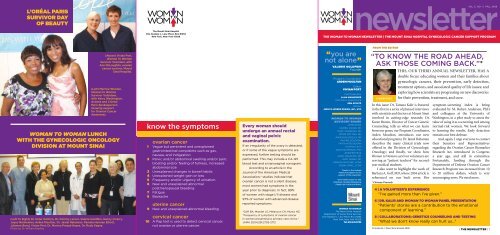
![December 2, 2012 [PDF] - Mount Sinai Hospital](https://img.yumpu.com/51092274/1/190x245/december-2-2012-pdf-mount-sinai-hospital.jpg?quality=85)
![January 21, 2013 [PDF] - Mount Sinai Hospital](https://img.yumpu.com/50916550/1/190x245/january-21-2013-pdf-mount-sinai-hospital.jpg?quality=85)
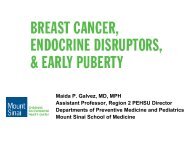
![February 3, 2013 [PDF] - Mount Sinai Hospital](https://img.yumpu.com/50584982/1/190x245/february-3-2013-pdf-mount-sinai-hospital.jpg?quality=85)
![March 18, 2012 [PDF] - Mount Sinai Hospital](https://img.yumpu.com/50462098/1/190x245/march-18-2012-pdf-mount-sinai-hospital.jpg?quality=85)

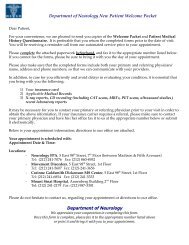
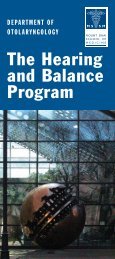
![Partners Program Guide [PDF] - Mount Sinai Hospital](https://img.yumpu.com/49411954/1/190x245/partners-program-guide-pdf-mount-sinai-hospital.jpg?quality=85)
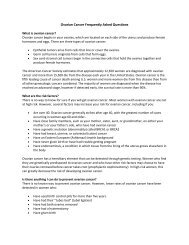
![March 19 - April 1, 2012 [PDF] - Mount Sinai Hospital](https://img.yumpu.com/48990923/1/190x245/march-19-april-1-2012-pdf-mount-sinai-hospital.jpg?quality=85)
![PGY-1 Residency Application [PDF] - Mount Sinai Hospital](https://img.yumpu.com/48577701/1/190x245/pgy-1-residency-application-pdf-mount-sinai-hospital.jpg?quality=85)
